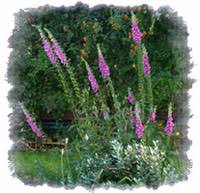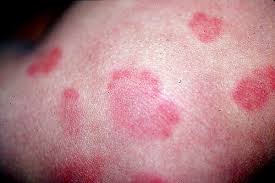

Over the years I have seen a number of people who liked the idea of working with plants but were forced to find a different career. There were just too many plants that gave them skin rashes. Most often the source could be found in a handful of usual suspects ; but not always. When the irritant plant could not be identified and then simply avoided, the sufferer would be forced into a life of fluorescent-lit air-conditioned misery.
In my own experience Foxglove was never a culprit but as it is a chemically active and potent plant that gives us a powereful heart drug I would not be surprised if it had other effects.
With the advent of Facebook and Twitter, victims need no longer suffer in silence. You can tell the world about your problems. You could publish a Blog.
Since neither myself or any colleage that I am aware of, have suffered negative consequences from any Digitalis species, I am putting up a site for someone who had a bad case of 'hives' from merely cutting back the spent flowering stems.
In pursuit of the 'deadly' Foxglove I just followed the trail even to a cooking show !
http://whatscookingamerica.net/Information/Foxglove.htm
Please read this and the subsequent correspondence carefully and critically as you are going to be told things like : "This plant is so poisonous that ingesting only .5 gram dried or 2 grams of fresh leaf is enough to kill a person. Another grim fairytale. Did you read this and then kept reading ? or did you stop for a moment and wonder how much is 2 grams ? Two grams is 0.070547 ounces. A typical paper clip is about a gram.
Do you believe that a piece of leaf from the flowering stem of a Digitalis equal to the mass or weight of two paper clips is going to kill a child ? I don't either.
HIVES : A 16th century Scottish word for urticaria ; a rash of round red weals on the skin that itch intensly, often caused by an allergic reaction. Hives occur when histamine is released causing fluids to leak from the smallest blood vessels and create swellings in the skin. Hives are very common and can appear alarmingly quickly; they can be gone by morning or persist for six weeks then go away with or without treatment. The causes are many, perhaps from something you ate; seafood, milk, eggs or from an infinite list; it could result from the sting of a bee or wasp or from the use of histamine- producing products such as Aspirin or Advil. In the majority of cases the cause is never known.
Apparently for some people, it can be a reaction to the plant tissue and pollen of Foxgloves. When the source is well-known or unknown the sufferer can only say, "Why me ?" and cope with it as best they can while waiting for it to go away. But if the cause is identified as Digitalis that they 'know' is a deadly poison a cascade of fears comes flooding over them as they anticipate the very worse outcome.
It is unfortunate that we can only learn of our unique susceptibilities the hard way, like the children with nut allergies and while they have our full sympathy and we must do what we can to protect them, garden centres will still be selling Foxgloves and Kraft will still be making peanut butter.
 She is a self-proclaimed plant hater.
She is a self-proclaimed plant hater.